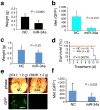The microRNA miR-34a inhibits prostate cancer stem cells and metastasis by directly repressing CD44
- PMID: 21240262
- PMCID: PMC3076220
- DOI: 10.1038/nm.2284
The microRNA miR-34a inhibits prostate cancer stem cells and metastasis by directly repressing CD44
Abstract
Cancer stem cells (CSCs), or tumor-initiating cells, are involved in tumor progression and metastasis. MicroRNAs (miRNAs) regulate both normal stem cells and CSCs, and dysregulation of miRNAs has been implicated in tumorigenesis. CSCs in many tumors--including cancers of the breast, pancreas, head and neck, colon, small intestine, liver, stomach, bladder and ovary--have been identified using the adhesion molecule CD44, either individually or in combination with other marker(s). Prostate CSCs with enhanced clonogenic and tumor-initiating and metastatic capacities are enriched in the CD44(+) cell population, but whether miRNAs regulate CD44(+) prostate cancer cells and prostate cancer metastasis remains unclear. Here we show, through expression analysis, that miR-34a, a p53 target, was underexpressed in CD44(+) prostate cancer cells purified from xenograft and primary tumors. Enforced expression of miR-34a in bulk or purified CD44(+) prostate cancer cells inhibited clonogenic expansion, tumor regeneration, and metastasis. In contrast, expression of miR-34a antagomirs in CD44(-) prostate cancer cells promoted tumor development and metastasis. Systemically delivered miR-34a inhibited prostate cancer metastasis and extended survival of tumor-bearing mice. We identified and validated CD44 as a direct and functional target of miR-34a and found that CD44 knockdown phenocopied miR-34a overexpression in inhibiting prostate cancer regeneration and metastasis. Our study shows that miR-34a is a key negative regulator of CD44(+) prostate cancer cells and establishes a strong rationale for developing miR-34a as a novel therapeutic agent against prostate CSCs.
Conflict of interest statement
K.K, J.F.W, A.G.B, and D.B are employees of Mirna Therapeutics, Inc., which develops miRNA-based therapeutics. Other authors declare no competing financial interests.
Figures




Comment in
-
Stemming a tumor with a little miR.Nat Med. 2011 Feb;17(2):162-4. doi: 10.1038/nm0211-162. Nat Med. 2011. PMID: 21297608 No abstract available.
-
Microrna: Micromanaging CD44.Nat Rev Cancer. 2011 Mar;11(3):156. doi: 10.1038/nrc3024. Epub 2011 Feb 10. Nat Rev Cancer. 2011. PMID: 21451552 No abstract available.
References
-
- Visvader JE, Lindeman GJ. Cancer stem cells in solid tumours: accumulating evidence and unresolved questions. Nat Rev Cancer. 2008;8:755–768. - PubMed
-
- Croce CM, Calin GA. miRNAs, cancer, and stem cell division. Cell. 2005;122:6–7. - PubMed
-
- Yu F, et al. let-7 regulates self-renewal and tumorigenicity of breast cancer cells. Cell. 2007;131:1109–1123. - PubMed
Publication types
MeSH terms
Substances
Grants and funding
LinkOut - more resources
Full Text Sources
Other Literature Sources
Medical
Research Materials
Miscellaneous

